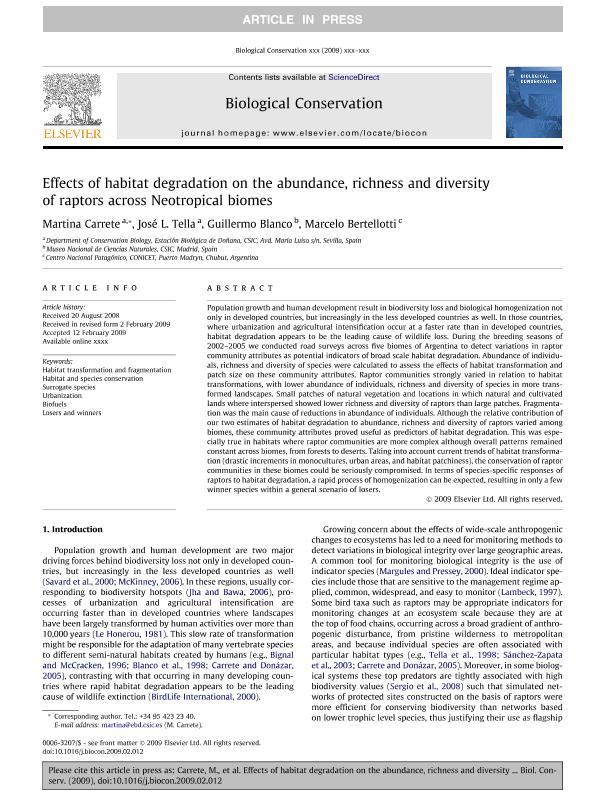Mostrar el registro sencillo del ítem
dc.contributor.author
Carrete, Martina

dc.contributor.author
Tella, José L.
dc.contributor.author
Blanco, Guillermo
dc.contributor.author
Bertellotti, Néstor Marcelo

dc.date.available
2020-01-28T21:02:28Z
dc.date.issued
2009-10
dc.identifier.citation
Carrete, Martina; Tella, José L.; Blanco, Guillermo; Bertellotti, Néstor Marcelo; Effects of habitat degradation on the abundance, richness and diversity of raptors across Neotropical biomes; Elsevier; Biological Conservation; 142; 10; 10-2009; 2002-2011
dc.identifier.issn
0006-3207
dc.identifier.uri
http://hdl.handle.net/11336/96077
dc.description.abstract
Population growth and human development result in biodiversity loss and biological homogenization not only in developed countries, but increasingly in the less developed countries as well. In those countries, where urbanization and agricultural intensification occur at a faster rate than in developed countries, habitat degradation appears to be the leading cause of wildlife loss. During the breeding seasons of 2002-2005 we conducted road surveys across five biomes of Argentina to detect variations in raptor community attributes as potential indicators of broad scale habitat degradation. Abundance of individuals, richness and diversity of species were calculated to assess the effects of habitat transformation and patch size on these community attributes. Raptor communities strongly varied in relation to habitat transformations, with lower abundance of individuals, richness and diversity of species in more transformed landscapes. Small patches of natural vegetation and locations in which natural and cultivated lands where interspersed showed lower richness and diversity of raptors than large patches. Fragmentation was the main cause of reductions in abundance of individuals. Although the relative contribution of our two estimates of habitat degradation to abundance, richness and diversity of raptors varied among biomes, these community attributes proved useful as predictors of habitat degradation. This was especially true in habitats where raptor communities are more complex although overall patterns remained constant across biomes, from forests to deserts. Taking into account current trends of habitat transformation (drastic increments in monocultures, urban areas, and habitat patchiness), the conservation of raptor communities in these biomes could be seriously compromised. In terms of species-specific responses of raptors to habitat degradation, a rapid process of homogenization can be expected, resulting in only a few winner species within a general scenario of losers.
dc.format
application/pdf
dc.language.iso
eng
dc.publisher
Elsevier

dc.rights
info:eu-repo/semantics/openAccess
dc.rights.uri
https://creativecommons.org/licenses/by-nc-nd/2.5/ar/
dc.subject
BIOFUELS
dc.subject
HABITAT AND SPECIES CONSERVATION
dc.subject
HABITAT TRANSFORMATION AND FRAGMENTATION
dc.subject
LOSERS AND WINNERS
dc.subject
SURROGATE SPECIES
dc.subject
URBANIZATION
dc.subject.classification
Ecología

dc.subject.classification
Ciencias Biológicas

dc.subject.classification
CIENCIAS NATURALES Y EXACTAS

dc.title
Effects of habitat degradation on the abundance, richness and diversity of raptors across Neotropical biomes
dc.type
info:eu-repo/semantics/article
dc.type
info:ar-repo/semantics/artículo
dc.type
info:eu-repo/semantics/publishedVersion
dc.date.updated
2019-12-12T14:56:29Z
dc.journal.volume
142
dc.journal.number
10
dc.journal.pagination
2002-2011
dc.journal.pais
Países Bajos

dc.journal.ciudad
Amsterdam
dc.description.fil
Fil: Carrete, Martina. Consejo Superior de Investigaciones Científicas. Estación Biológica de Doñana; España
dc.description.fil
Fil: Tella, José L.. Consejo Superior de Investigaciones Científicas. Estación Biológica de Doñana; España
dc.description.fil
Fil: Blanco, Guillermo. Consejo Superior de Investigaciones Científicas; España
dc.description.fil
Fil: Bertellotti, Néstor Marcelo. Consejo Nacional de Investigaciones Científicas y Técnicas. Centro Científico Tecnológico Conicet - Centro Nacional Patagónico; Argentina
dc.journal.title
Biological Conservation

dc.relation.alternativeid
info:eu-repo/semantics/altIdentifier/doi/http://dx.doi.org/10.1016/j.biocon.2009.02.012
dc.relation.alternativeid
info:eu-repo/semantics/altIdentifier/url/https://www.sciencedirect.com/science/article/pii/S0006320709000871
Archivos asociados
